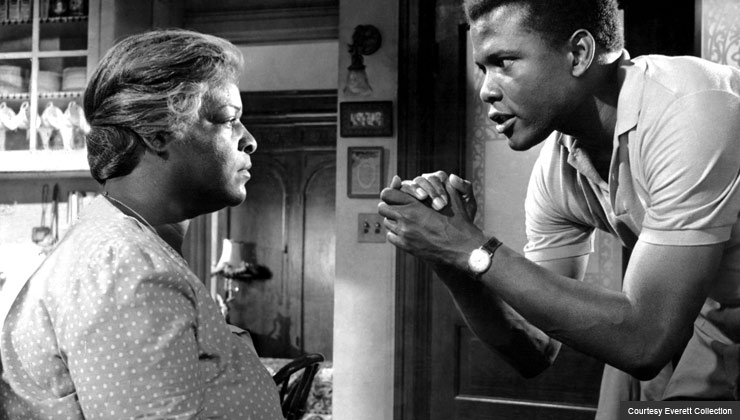Staying Fit


I can't say with total precision what $10,000 could buy 50 years ago, but from childhood memory I know that in 1958, a new Cadillac dented your bank account by four grand. From this, we can see how much of a life-changer $10,000 would have meant to the African American family in Lorraine Hansberry's landmark 1959 play A Raisin in the Sun, whose screen version was something of a landmark itself when it opened 50 years ago this spring.
In what was then the latest boost to his escalating screen career, Sidney Poitier played patriarch-by-default Walter Lee Younger — getting older at 35 and working as chauffeur to a white employer. Walter is borderline desperate to invest his late father's insurance check in (he hopes) a lot-improving liquor store — agitating his religious mother (Claudia McNeil, who, like Poitier, recreated her Tony-nominated stage performance). There's also the competing med school aspiration of sister Beneatha (Diana Sands) — itself risky given her flighty history of tackling self-improvement "projects," such as horse riding or guitar lessons, then quitting.


AARP Membership— $12 for your first year when you sign up for Automatic Renewal
Get instant access to members-only products and hundreds of discounts, a free second membership, and a subscription to AARP the Magazine.
The family's raucous monetary squabbling sounds universally middle class — or at least the kind engaged in by folks eager to attain that status. But black characters with these concerns were next to unheard of on mainstream screens half-a-century ago when Columbia Pictures, which released Sun, was also releasing Underworld U.S.A. and Gidget Goes Hawaiian.
Claiming "first" distinctions for major studio releases is dicey and usually courts correction. Just two years earlier, for example, United Artists had released Take a Giant Step — tiny but worth mentioning because it is, just as we speak, premiering on DVD as an "on-demand" title from Twentieth Century Fox Home Entertainment. Starring singer Johnny Nash and Sun's Ruby Dee as a housemaid who catches his eye, it had a predominantly black cast and dealt with the growing pains of a well-bred teenager of color.
Still. Until then, mainstream Hollywood had near-exclusively hired black casts for musicals or dramas with music (Hallelujah!, Cabin in the Sky, Carmen Jones, St. Louis Blues), or given black actors occasional good roles in films where whites were the primary focus (Poitier's own screen debut in 1950's No Way Out); or even cast white actors as blacks in dramas about racial "passing" (Pinky, Lost Boundaries). Taking his own giant step, Poitier had already been a "co-equal" groundbreaker. He'd played the best buddy of white fellow dockworker John Cassavetes in 1957's Edge of the City and gotten an Oscar nomination as Tony Curtis' chain gang "partner" in The Defiant Ones, which no black male actor had ever done.

































































More From AARP
17 Essential Films About the Black Experience
From ‘A Raisin in the Sun’ to ‘Get Out,’ these movies span the vast culture of Black life in America'They've Gotta Have Us': A Brilliant History of Black Cinema
Documentary casts fascinating light on a 'renaissance of black film'These 12 Super-Inspiring Movies About Teachers Will Warm Your Heart
Celebrate National Teachers Day with these wonderful films about classroom heroes